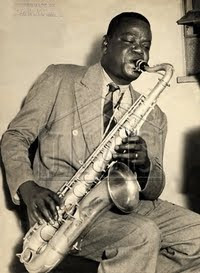Trio Baru - Alma Brasileira
 Recently the Brazilian Trio Baru released its first album under its own name, entitled Alma Brasileira. The Trio Baru was founded six years ago by three skilled Brazilian instrumentalists: Cavaquinho and guitar player Nelson Latif - acoustic guitar player João Bosco Oliveira and percussionist Rafael dos Santos.
Recently the Brazilian Trio Baru released its first album under its own name, entitled Alma Brasileira. The Trio Baru was founded six years ago by three skilled Brazilian instrumentalists: Cavaquinho and guitar player Nelson Latif - acoustic guitar player João Bosco Oliveira and percussionist Rafael dos Santos.
 Nelson Latif ( source: nelsonlatif.com)
Nelson Latif ( source: nelsonlatif.com)
Nelson Latif, born in Sao Paulo, was raised with Choro music, a music style that goes back to the 1870s when musicians in Rio the Janeiro developed this creative musical style. Some people put Choro music or Chorinho on a par with the early US jazz styles, like Ragtime and Dixieland music and that's not so strange as you can say that it has, more or less, the same roots and it developed in the same periods. Choro was primarily an instrumental form, and to a North American (and European) ear it might sound a litle like a small Dixieland jazz combo playing with strange rhythms, extreme melodic leaps, unexpected modulations, and occasional breakneck tempos. ( source: The Billboard Book of Brazilian Music.). When I first heard a Choro band ( Choro Brasil Scandinavia) at the Copenhagen Jazz Festival in 2005, improvising, playing together in a so-called Roda de Chora in a bar after their concert at Mandala, featuring members of the Choro Brasil Scandinavia and jazz guitarist Jacob Fischer, it felt as if the New Orleans spirit of the collective improvisation had re-borned, fresh and with an enthusiasm, I'd rarely heard in traditional jazz music now-a-days. Some friends, who visited the recently organized Roda de samba e Choro in Amsterdam, organized by Nelson Latif too, had that same experience.
 Trio Baru: f.l.t.r.: Nelson Latif - Rafael dos Santos - Bosco Oliveira. (photo courtesy: Clausem Bonifacio)
Trio Baru: f.l.t.r.: Nelson Latif - Rafael dos Santos - Bosco Oliveira. (photo courtesy: Clausem Bonifacio)
Nelson Latif's trio combines Jazz and Choro and other Brazilian musical influences in his unique style. Nelson Latif moved to Amsterdam more then 20 years ago and the cavaquinho became his main instrument, although he loves to play the 7-string acoustic guitar, the violão de sete cordas, the v.7 which has an extra bass string ( usually tuned to C ), so it can used for bass lines too. Nelson Latif played and recorded with dozens of Dutch jazz musicians, like vocalist Joseé Koning and Joeri De Graaf ( they can be heard at the great album Chôro, samba e afins).
Bosco Oliveira, who plays the acoustic guitar, was born in Brasilia, and started to play the guitar eight years old - he graduated twenty years ago at the University of Brasilia and is an expert in the Spanish Flamenco guitar style - Rafael dos Santos is from São Luis and knows how to mix traditional Brazilian music with modern jazz styles.
 Fragment of Heitor Villa-Lobos composition: Bachianas Brasileiras Nº 5 (source: Choro: A Social History of a Brazilian Music)
Fragment of Heitor Villa-Lobos composition: Bachianas Brasileiras Nº 5 (source: Choro: A Social History of a Brazilian Music)
Nelson Latif writes in the liner notes that he wanted to make a survey of the different Brazilian music styles, as a trajectory of Brazilian instrumental music, hoping to take the listener on a little journey inside the sonorous realms of our people's imagination. The album contains a dozen tracks, most original compositions by great Brazilian composers, inspired by music styles like Choro: Waldir Azevedo, Ernesto Nazareth and Jacob do Bandolim - Bossa Nova: Baden Powell (de Aquinho) - Jazz-Fusion: Airto Mocedo and popular Brazilian music: Paulinho da Viola and Milton Nascimento. The Choro music revived during the 1950s and 1960s due to great musicians like Jacob do Bandolim and Waldir Azevedo, both present with two tracks. The tunes Nelson Latif and his Trio Baru selected are seldom heard, like Santa Morena and Alma Brasileira; the latter originally recorded by Jacob do Bandolim and his Regional do Canhoto in the 1950s. I personally liked the tune entitled Bachianas Brasileiras no. 5, a tribute to the Orchestral Suite #3 by Johann Sebastian Bach, composed in the 1940s by the great guitarist and composer Heitar Villa-Lobos.
 Nelson Latif ( source: neslonlatif.com)
Nelson Latif ( source: neslonlatif.com)
Nelson Latif released some more great albums like Movimento - the before mentioned Chôro, samba e afins, with guitar player Joeri de Graaf and the album Tribute to João Pernambuco, dedicated to the music of the legendary Brazilian composer and guitar player João Teixeira de Guimarães, better known as João Pernambuco.
If you love Brazilian (string) music in general and Choro music in particular, try to find yourself a copy by this great Trio Baru: Alma Brasilieira. You can get more info about how to obtain a copy at the Nelson Latif website.
Deze blog verschijnt in het Nederlands op de Keep Swingingblog.
Hans Koert
keepswinging@live.nl
Ask for the Keep Swinging news letter if you love to be informed about the Choro-Music blogs.



3 Comments:
Thanks, Hans, for this review of a great cd by Trio Baru. The title of the disc says it all, this is the true Brazilian spirit expressed in music by three skilled musicians. Gret repertoire chosen for the cd and excellent excecution of the tunes by the trio.
Jo
I really love Brazilian music. I am from the U.S. and started listening to Bossa Nova, it was my first exposure to Brazilian style music genre.
Thanks for sharing superb music. Your web site is very cool. I really love Brazilian Music.
Post a Comment
<< Home